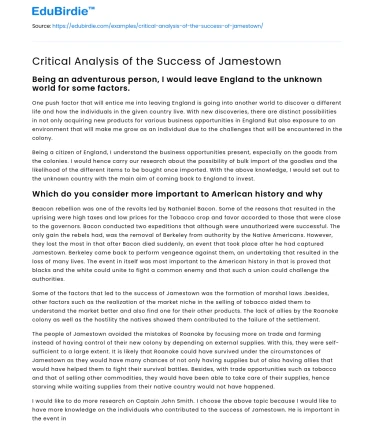Introduction
Founded in 1607, Jamestown holds the distinction of being the first permanent English settlement in North America. Situated in present-day Virginia, its establishment marked a pivotal moment in the colonial expansion of England. Despite numerous adversities—ranging from hostile relations with Indigenous peoples to severe famine and disease—Jamestown managed to endure where previous attempts had failed. The success of Jamestown is often attributed to a combination of leadership, adaptation, and economic innovation, particularly through the introduction of tobacco cultivation. This essay critically examines the factors that contributed to Jamestown’s success, while also considering counterarguments that suggest its achievements were more a product of circumstance than strategy. Through a detailed analysis, this paper aims to provide a nuanced understanding of Jamestown’s legacy in the context of early American history.
Leadership and Governance
The role of leadership and governance in Jamestown's survival cannot be overstated. Captain John Smith, one of the colony's most influential leaders, implemented strict regulations and established trade relations with the Powhatan Confederacy, which were crucial during the colony’s formative years. Smith's leadership style, though often authoritarian, was instrumental in maintaining order and ensuring the colony's immediate survival. According to historian Karen Ordahl Kupperman, Smith's leadership was "a necessary, if temporary, solution to the challenges faced by the colonists" (Kupperman, 2007). His ability to enforce discipline and negotiate with Indigenous groups provided a temporary reprieve from the internal and external threats that plagued the settlement.
Save your time!
We can take care of your essay
- Proper editing and formatting
- Free revision, title page, and bibliography
- Flexible prices and money-back guarantee
However, it is essential to consider the counterargument that Smith's leadership was not a sustainable model for long-term success. Critics argue that the colony's reliance on authoritarian governance created a dependency that hindered the development of self-sustaining community structures. Furthermore, the relationship with the Indigenous populations, while initially beneficial, eventually soured, leading to increased hostilities. This suggests that while leadership played a role in the immediate survival of Jamestown, it was not the sole factor in its eventual success.
Transitioning from leadership to the colony’s economic strategies, it becomes apparent that adaptability was key to Jamestown’s enduring legacy. The introduction of tobacco as a cash crop by John Rolfe in 1612 marked a significant turning point for the settlement. This development not only provided economic stability but also attracted new settlers, further strengthening the colony’s foundations.
Economic Adaptation and Innovation
The economic success of Jamestown is largely attributed to the cultivation of tobacco, which became the colony's primary export and a significant economic driver. John Rolfe's introduction of a sweeter strain of tobacco suited to European tastes transformed the colony's fortunes, creating a lucrative trade that attracted investment and manpower. As remarked by historian Edmund Morgan, "tobacco was the lifeblood of Jamestown, transforming it from a struggling outpost to a thriving colony" (Morgan, 1975).
The economic model based on tobacco cultivation, however, was not without its drawbacks. It led to an over-reliance on a single crop, which made the colony vulnerable to fluctuations in tobacco prices and market demand. Additionally, the labor-intensive nature of tobacco farming precipitated the introduction of indentured servitude and, eventually, African slavery, setting a precedent for labor systems that would have enduring social and ethical consequences.
While the economic success of tobacco is undeniable, it is crucial to acknowledge that this success was contingent upon factors such as fertile soil and favorable climatic conditions, which were not entirely within the colonists' control. As such, the argument can be made that Jamestown's economic achievements were as much a product of environmental fortuity as they were of human ingenuity.
Transitioning from economic adaptations to social and cultural interactions, it is clear that the complex dynamics between the colonists and Indigenous peoples played a crucial role in shaping Jamestown’s trajectory. These interactions, though fraught with conflict, were integral to the colony's survival and adaptation strategies.
Social Dynamics and Indigenous Relations
Jamestown's survival was intricately linked to its interactions with the Indigenous peoples, particularly the Powhatan Confederacy. Initial relations were characterized by trade and mutual benefit, with the Powhatan providing essential food supplies to the settlers. However, tensions soon escalated, culminating in intermittent conflicts that threatened the colony's existence. Despite these challenges, the social dynamics between the English settlers and the Indigenous populations were pivotal in shaping the colony's adaptive strategies.
Anthropologist Helen Rountree highlights the complexities of these interactions, noting that "the Powhatan were both allies and adversaries, their relationship with the English constantly evolving in response to changing circumstances" (Rountree, 1990). This duality underscores the adaptability of the settlers, who, despite hostilities, learned to navigate the delicate balance of diplomacy and conflict with the Indigenous peoples.
Nevertheless, the reliance on Indigenous knowledge and resources raises questions about the settlers' ability to sustain themselves independently. Critics argue that the colony's dependency on Indigenous assistance reveals a fundamental weakness in its initial planning and resource management strategies. This perspective challenges the notion of Jamestown's success as purely a result of colonial ingenuity, suggesting instead that it was a collaborative effort, albeit fraught with exploitation and power imbalances.
Conclusion
In analyzing the success of Jamestown, it becomes evident that a confluence of factors—leadership, economic adaptation, and complex social dynamics—contributed to its endurance as a settlement. While figures like John Smith and John Rolfe played crucial roles, their contributions were part of a broader tapestry of interactions and adaptations that ensured the colony's survival. However, it is important to recognize that the legacy of Jamestown is not without its controversies, particularly regarding its social and economic practices. The colony's reliance on tobacco cultivation and its interactions with Indigenous peoples highlight the ethical and strategic complexities of its success. Ultimately, Jamestown's legacy serves as a testament to the multifaceted nature of colonial enterprise, reflecting both the potential for innovation and the consequences of imperial expansion.






 Stuck on your essay?
Stuck on your essay?

